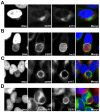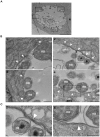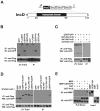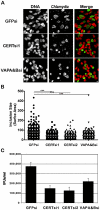The lipid transfer protein CERT interacts with the Chlamydia inclusion protein IncD and participates to ER-Chlamydia inclusion membrane contact sites
- PMID: 21731489
- PMCID: PMC3121800
- DOI: 10.1371/journal.ppat.1002092
The lipid transfer protein CERT interacts with the Chlamydia inclusion protein IncD and participates to ER-Chlamydia inclusion membrane contact sites
Abstract
Bacterial pathogens that reside in membrane bound compartment manipulate the host cell machinery to establish and maintain their intracellular niche. The hijacking of inter-organelle vesicular trafficking through the targeting of small GTPases or SNARE proteins has been well established. Here, we show that intracellular pathogens also establish direct membrane contact sites with organelles and exploit non-vesicular transport machinery. We identified the ER-to-Golgi ceramide transfer protein CERT as a host cell factor specifically recruited to the inclusion, a membrane-bound compartment harboring the obligate intracellular pathogen Chlamydia trachomatis. We further showed that CERT recruitment to the inclusion correlated with the recruitment of VAPA/B-positive tubules in close proximity of the inclusion membrane, suggesting that ER-Inclusion membrane contact sites are formed upon C. trachomatis infection. Moreover, we identified the C. trachomatis effector protein IncD as a specific binding partner for CERT. Finally we showed that depletion of either CERT or the VAP proteins impaired bacterial development. We propose that the presence of IncD, CERT, VAPA/B, and potentially additional host and/or bacterial factors, at points of contact between the ER and the inclusion membrane provides a specialized metabolic and/or signaling microenvironment favorable to bacterial development.
Conflict of interest statement
The authors have declared that no competing interests exist.
Figures









Comment in
-
Rerouting of host lipids by bacteria: are you CERTain you need a vesicle?PLoS Pathog. 2011 Sep;7(9):e1002208. doi: 10.1371/journal.ppat.1002208. Epub 2011 Sep 1. PLoS Pathog. 2011. PMID: 21909265 Free PMC article. No abstract available.
Similar articles
-
Expression of the effector protein IncD in Chlamydia trachomatis mediates recruitment of the lipid transfer protein CERT and the endoplasmic reticulum-resident protein VAPB to the inclusion membrane.Infect Immun. 2014 May;82(5):2037-47. doi: 10.1128/IAI.01530-14. Epub 2014 Mar 4. Infect Immun. 2014. PMID: 24595143 Free PMC article.
-
Chlamydia trachomatis co-opts GBF1 and CERT to acquire host sphingomyelin for distinct roles during intracellular development.PLoS Pathog. 2011 Sep;7(9):e1002198. doi: 10.1371/journal.ppat.1002198. Epub 2011 Sep 1. PLoS Pathog. 2011. PMID: 21909260 Free PMC article.
-
STIM1 Is a Novel Component of ER-Chlamydia trachomatis Inclusion Membrane Contact Sites.PLoS One. 2015 Apr 27;10(4):e0125671. doi: 10.1371/journal.pone.0125671. eCollection 2015. PLoS One. 2015. PMID: 25915399 Free PMC article.
-
Chlamydiae interaction with the endoplasmic reticulum: contact, function and consequences.Cell Microbiol. 2015 Jul;17(7):959-66. doi: 10.1111/cmi.12455. Epub 2015 May 27. Cell Microbiol. 2015. PMID: 25930206 Free PMC article. Review.
-
Hijacking of Membrane Contact Sites by Intracellular Bacterial Pathogens.Adv Exp Med Biol. 2017;997:211-223. doi: 10.1007/978-981-10-4567-7_16. Adv Exp Med Biol. 2017. PMID: 28815533 Review.
Cited by
-
A C. trachomatis cloning vector and the generation of C. trachomatis strains expressing fluorescent proteins under the control of a C. trachomatis promoter.PLoS One. 2013;8(2):e57090. doi: 10.1371/journal.pone.0057090. Epub 2013 Feb 18. PLoS One. 2013. PMID: 23441233 Free PMC article.
-
Chlamydia cell biology and pathogenesis.Nat Rev Microbiol. 2016 Jun;14(6):385-400. doi: 10.1038/nrmicro.2016.30. Epub 2016 Apr 25. Nat Rev Microbiol. 2016. PMID: 27108705 Free PMC article. Review.
-
Sphingolipid Metabolism and Transport in Chlamydia trachomatis and Chlamydia psittaci Infections.Front Cell Dev Biol. 2019 Oct 4;7:223. doi: 10.3389/fcell.2019.00223. eCollection 2019. Front Cell Dev Biol. 2019. PMID: 31637241 Free PMC article. Review.
-
The Leishmania Parasitophorous Vacuole Membrane at the Parasite-Host Interface.Yale J Biol Med. 2019 Sep 20;92(3):511-521. eCollection 2019 Sep. Yale J Biol Med. 2019. PMID: 31543712 Free PMC article. Review.
-
Targeting host lipid flows: Exploring new antiviral and antibiotic strategies.Cell Microbiol. 2019 Mar;21(3):e12996. doi: 10.1111/cmi.12996. Epub 2019 Jan 17. Cell Microbiol. 2019. PMID: 30585688 Free PMC article. Review.
References
-
- Dautry-Varsat A, Subtil A, Hackstadt T. Recent insights into the mechanisms of Chlamydia entry. Cell Microbiol. 2005;7:1714–1722. - PubMed
Publication types
MeSH terms
Substances
Grants and funding
LinkOut - more resources
Full Text Sources
Other Literature Sources

